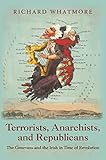Terrorists, Anarchists, and Republicans : The Genevans and the Irish in Time of Revolution / Richard Whatmore.
Material type: TextPublisher: Princeton, NJ : Princeton University Press, [2019]Copyright date: ©2019Description: 1 online resource (512 p.) : 20 b/w illusContent type:
TextPublisher: Princeton, NJ : Princeton University Press, [2019]Copyright date: ©2019Description: 1 online resource (512 p.) : 20 b/w illusContent type: - 9780691168777
- 9780691197470
- 941.507 23
- DA949 .W4 2020
- online - DeGruyter
- Issued also in print.
| Item type | Current library | Call number | URL | Status | Notes | Barcode | |
|---|---|---|---|---|---|---|---|
 eBook
eBook
|
Biblioteca "Angelicum" Pont. Univ. S.Tommaso d'Aquino Nuvola online | online - DeGruyter (Browse shelf(Opens below)) | Online access | Not for loan (Accesso limitato) | Accesso per gli utenti autorizzati / Access for authorized users | (dgr)9780691197470 |
Frontmatter -- Contents -- Illustrations -- Preface -- Acknowledgments -- PART I. Rebellion -- Chapter one. The Power of Place -- Chapter two. The Waterford Experiment -- PART II. Divided Geneva -- Chapter three. Religion and Enlightenment -- Chapter four. Extremism -- Chapter five. Civil War -- Chapter six. Revolution and Exodus -- PART III. Disunited Ireland -- Chapter seven. Ireland: Oppression and Opportunity -- Chapter eight. Shelburne -- Chapter nine. New Geneva -- Chapter ten. Barracks and Prison -- Conclusion. After Revolution -- Notes -- Bibliography -- Index
restricted access online access with authorization star
http://purl.org/coar/access_right/c_16ec
A bloody episode that epitomized the political dilemmas of the eighteenth centuryIn 1798, members of the United Irishmen were massacred by the British amid the crumbling walls of a half-built town near Waterford in Ireland. Many of the Irish were republicans inspired by the French Revolution, and the site of their demise was known as Genevan Barracks. The Barracks were the remnants of an experimental community called New Geneva, a settlement of Calvinist republican rebels who fled the continent in 1782. The British believed that the rectitude and industriousness of these imported revolutionaries would have a positive effect on the Irish populace. The experiment was abandoned, however, after the Calvinists demanded greater independence and more state money for their project. Terrorists, Anarchists, and Republicans tells the story of a utopian city inspired by a spirit of liberty and republican values being turned into a place where republicans who had fought for liberty were extinguished by the might of empire.Richard Whatmore brings to life a violent age in which powerful states like Britain and France intervened in the affairs of smaller, weaker countries, justifying their actions on the grounds that they were stopping anarchists and terrorists from destroying society, religion, and government. The Genevans and the Irish rebels, in turn, saw themselves as advocates of republican virtue, willing to sacrifice themselves for liberty, rights, and the public good. Terrorists, Anarchists, and Republicans shows how the massacre at Genevan Barracks marked an end to the old Europe of diverse political forms, and the ascendancy of powerful states seeking empire and markets-in many respects the end of enlightenment itself.
Issued also in print.
Mode of access: Internet via World Wide Web.
In English.
Description based on online resource; title from PDF title page (publisher's Web site, viewed 21. Jun 2021)


